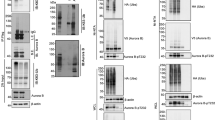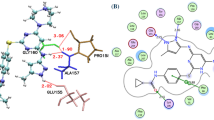Abstract
Reversine is a synthetic molecule capable of inducing dedifferentiation of C2C12, a murine myoblast cell line, into multipotent progenitor cells, which can be redirected to differentiate in nonmuscle cell types under appropriate conditions. Reversine is also a potent inhibitor of Aurora B, a protein kinase required for mitotic chromosome segregation, spindle checkpoint function, cytokinesis and histone H3 phosphorylation, raising the possibility that the dedifferentiation capability of reversine is mediated through the inhibition of Aurora B. Indeed, here we show that several other well-characterized Aurora B inhibitors are capable of dedifferentiating C2C12 myoblasts. Significantly, expressing drug-resistant Aurora B mutants, which are insensitive to reversine block the dedifferentiation process, indicating that Aurora B kinase activity is required to maintain the differentiated state. We show that the inhibition of the spindle checkpoint or cytokinesis per se is not sufficient for dedifferentiation. Rather, our data support a model whereby changes in histone H3 phosphorylation result in chromatin remodeling, which in turn restores the multipotent state.
Similar content being viewed by others
Log in or create a free account to read this content
Gain free access to this article, as well as selected content from this journal and more on nature.com
or
Abbreviations
- ES:
-
embryonic stem cells
- ap2:
-
adipocyte fatty acid-binding protein
- LPL:
-
lipoprotein lipase
- ALP:
-
alkaline phosphatase
- NMMII:
-
nonmuscle myosin II heavy chain
- MEK:
-
mitogen-activated extracellular signal-regulated kinase
- ADM:
-
adipogenic-differentiating medium
- ODM:
-
osteogenic-differentiating medium
- MRFs:
-
muscle regulatory factors
- Id(s):
-
inhibitor of differentiation(s)
- Myf5:
-
myogenic factor 5
- Lys:
-
lysine
- Ser:
-
serine
- p:
-
phospho
- me:
-
methyl
References
Hochedlinger K, Jaenisch R . Nuclear reprogramming and pluripotency. Nature 2006; 441: 1061–1067.
Cowan CA, Atienza J, Melton DA, Eggan K . Nuclear reprogramming of somatic cells after fusion with human embryonic stem cells. Science 2005; 309: 1369–1373.
Takahashi K, Yamanaka S . Induction of pluripotent stem cells from mouse embryonic and adult fibroblast cultures by defined factors. Cell 2006; 126: 663–676.
Wernig M, Meissner A, Foreman R, Brambrink T, Ku M, Hochedlinger K et al. In vitro reprogramming of fibroblasts into a pluripotent ES-cell-like state. Nature 2007; 448: 318–324.
Maherali N, Sridharan R, Xie W, Utikal J, Eminli S, Arnold K et al. Directly reprogrammed fibroblasts show global epigenetic remodeling and widespread tissue contribution. Cell Stem Cell 2007; 1: 55–70.
Odelberg SJ, Kollhoff A, Keating MT . Dedifferentiation of mammalian myotubes induced by msx1. Cell 2000; 103: 1099–1109.
Chen S, Zhang Q, Wu X, Schultz PG . Ding dedifferentiation of lineage-committed cells by a small molecule. J Am Chem Soc 2004; 126: 410–411.
Anastasia L, Sampaolesi M, Papini N, Oleari D, Lamorte G, Tringali C et al. Reversine-treated fibroblasts acquire myogenic competence in vitro and in regenerating skeletal muscle. Cell Death Differ 2006; 13: 2042–2051.
D'Alise AM, Amabile G, Iovino M, Di Giorgio FP, Bartiromo M, Sessa F et al. Reversine, a novel Aurora kinases inhibitor, inhibits colony formation of human acute myeloid leukemia cells. Mol Cancer Ther 2008; 7: 1140–1149.
Barr AR, Gergely F . Aurora-A: the maker and breaker of spindle poles. J Cell Sci 2007; 120: 2987–2996.
Vader G, Cruijsen CW, van Harn T, Vromans MJ, Medema RH, Lens SM . The chromosomal passenger complex controls spindle checkpoint function independent from its role in correcting microtubule kinetochore interactions. Mol Biol Cell 2007; 18: 4553–4564.
Musacchio A, Salmon ED . The spindle-assembly checkpoint in space and time. Nat Rev Mol Cell Biol 2007; 8: 379–393.
Fischle W, Tseng BS, Dormann HL, Ueberheide BM, Garcia BA, Shabanowitz J et al. Regulation of HP1-chromatin binding by histone H3 methylation andphosphorylation. Nature 2005; 438: 1116–1122.
Terada Y . Aurora-B/AIM-1 regulates the dynamic behavior of HP1alpha at the G2-M transition. Mol Biol Cell 2006; 17: 3232–3241.
Jenuwein T, Allis CD . Translating the histone code. Science 2001; 293: 1074–1080.
Williams L, Zhao J, Morozova N, Li Y, Avivi Y, Grafi G . Chromatin reorganization accompanying cellular dedifferentiation is associated with modifications of histone H3, redistribution of HP1, and activation of E2F-target genes. Dev Dyn 2003; 228: 113–120.
Sabbattini P, Canzonetta C, Sjoberg M, Nikic S, Georgiou A, Kemball-Cook G et al. A novel role for the Aurora B kinase in epigenetic marking of silent chromatin in differentiated postmitotic cells. EMBO J 2007; 26: 4657–4669.
Chen S, Takanashi S, Zhang Q, Xiong W, Zhu S, Peters EC et al. Reversine increases the plasticity of lineage-committed mammalian cells. Proc Natl Acad Sci USA 2007; 104: 10482–10487.
Cohen P, Goedert M . GSK3 inhibitors: development and therapeutic potential. Nat Rev Drug Discov 2004; 3: 479–487.
Hauf S, Cole RW, LaTerra S, Zimmer C, Schnapp G, Walter R et al. The small molecule hesperadin reveals a role for Aurora B in correcting kinetochore–microtubule attachment and in maintaining the spindle assembly checkpoint. J Cell Biol 2003; 161: 281–294.
Harrington EA, Bebbington D, Moore J, Rasmussen RK, Ajose-Adeogun AO, Nakayama T et al. VX-680, a potent and selective small-molecule inhibitor of the Aurora kinases, suppresses tumor growth in vivo. Nat Med 2004; 10: 262–267.
Manfredi MG, Ecsedy JA, Meetze KA, Balani SK, Burenkova O, Chen W et al. Antitumor activity of MLN8054, an orally active small-molecule inhibitor of Aurora A kinase. Proc Natl Acad Sci USA 2007; 104: 4106–4111.
Girdler F, Sessa S, Patercoli S, Villa F, Musacchio A, Taylor S . Molecular basis of drug-resistance in Aurora kinases. Chem Biol 2008; 15: 552–562.
Ditchfield C, Johnson VL, Tighe A, Ellston R, Haworth C, Johnson T . Aurora B couples chromosome alignment with anaphase by targeting BubR1, Mad2, and Cenp-E to kinetochores. J Cell Biol 2003; 161: 267–280.
Jen Y, Weintraub H, Benezra R . Overexpression of Id protein inhibits the muscle differentiation program: in vivo association of Id with E2A proteins. Genes Dev 1992; 6: 1466–1479.
Braun T, Buschhausen-Denker G, Bober E, Tannich E, Arnold HH . A novel human muscle factor related to but distinct from MyoD1 induces myogenic conversion in 10T1/2 fibroblasts. EMBO J 1989; 8: 701–709.
Davis RL, Weintraub H, Lassar AB . Expression of a single transfected cDNA converts fibroblasts to myoblasts. Cell 1987; 51: 987–1000.
Tapscott SJ, Davis RL, Thayer MJ, Cheng PF, Weintraub H, Lassar AB . MyoD1: a nuclear phosphoprotein requiring a Myc homology region to convert fibroblasts to myoblasts. Science 1988; 242: 405–411.
Clayton AL, Rose S, Barratt MJ, Mahadevan LC . Phosphoacetylation of histone H3 on c-fos- and c-jun-associated nucleosomes upon gene activation. EMBO J 2000; 19: 3714–3726.
Mal A, Harter ML . MyoD is functionally linked to the silencing of a muscle-specific regulatory gene prior to skeletal myogenesis. Proc Natl Acad Sci USA 2003; 100: 1735–1739.
Calhabeu F, Lafont J, Le Dreau G, Laurent M, Kazazian C, Schaeffer L et al. NOV/CCN3 impairs muscle cell commitment and differentiation. Exp Cell Res 2006; 312: 1876–1889.
Gersbach CA, Byers BA, Pavlath GK, García AJ . Runx2/Cbfa1 stimulates transdifferentiation of primary skeletal myoblasts into a mineralizing osteoblastic phenotype. Exp Cell Res 2004; 300: 406–417.
Litt MD, Simpson M, Recillas-Targa F, Prioleau MN, Felsenfeld G . Transitions in histone acetylation reveal boundaries of three separately regulated neighboring loci. EMBO J 2001; 20: 2224–2235.
Acknowledgements
We are very grateful to Dr. Fabio Formiggini and to Dynamic Imaging Microscopy facility of CEINGE Biotecnologie Avanzate for the help with confocal microscopy. SST is a Cancer Research UK senior fellow.
Author information
Authors and Affiliations
Corresponding author
Additional information
Edited by G Cossu
Supplementary Information accompanies the paper on Cell Death and Differentiation website (http://www.nature.com/cdd)
Supplementary information
Rights and permissions
About this article
Cite this article
Amabile, G., D'Alise, A., Iovino, M. et al. The Aurora B kinase activity is required for the maintenance of the differentiated state of murine myoblasts. Cell Death Differ 16, 321–330 (2009). https://doi.org/10.1038/cdd.2008.156
Received:
Revised:
Accepted:
Published:
Issue date:
DOI: https://doi.org/10.1038/cdd.2008.156
Keywords
This article is cited by
-
Reversine exerts cytotoxic effects through multiple cell death mechanisms in acute lymphoblastic leukemia
Cellular Oncology (2020)
-
Relation of AURKB over-expression to low survival rate in BCRA and reversine-modulated aurora B kinase in breast cancer cell lines
Cancer Cell International (2019)
-
Loss of Centromere Cohesion in Aneuploid Human Oocytes Correlates with Decreased Kinetochore Localization of the Sac Proteins Bub1 and Bubr1
Scientific Reports (2017)
-
Some leopards can change their spots: potential repositioning of stem cell reprogramming compounds as anti-cancer agents
Cell Biology and Toxicology (2016)
-
Reversine suppresses oral squamous cell carcinoma via cell cycle arrest and concomitantly apoptosis and autophagy
Journal of Biomedical Science (2012)



